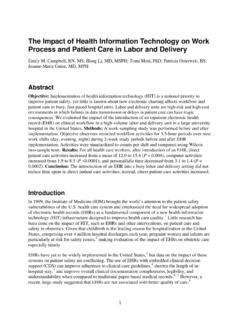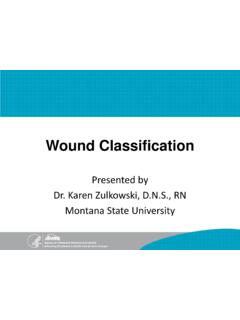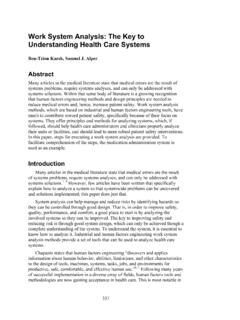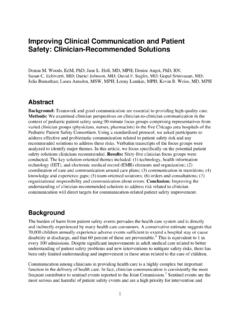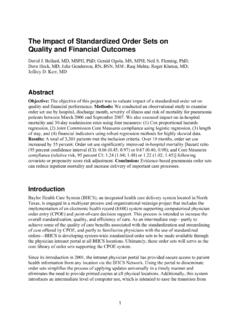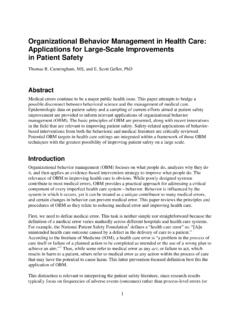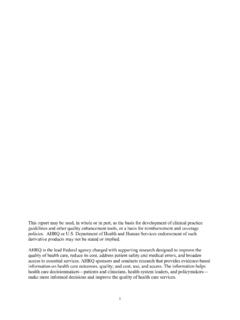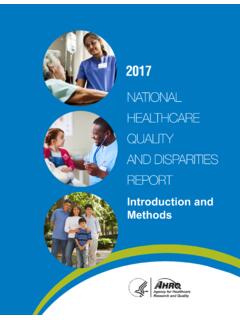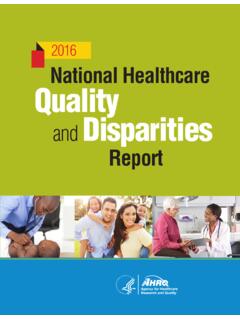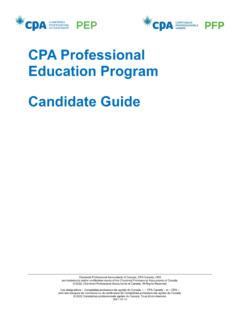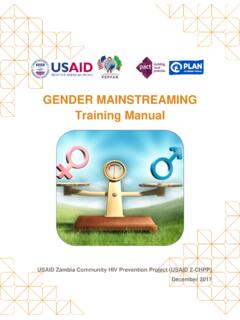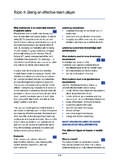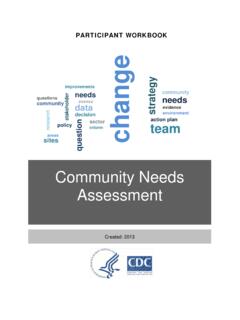Transcription of Gap Analysis Facilitator’s Guide
1 Purpose: To evaluate the extent to which current processes align with the Communication and Optimal Resolution (CANDOR) process and includes; Identifying the existing process Identifying the existing outcome(s) Identifying the desired outcome(s) Identifying and documenting the gap(s)Who should use this tool? The CANDOR Implementation TeamHow to use this tool: Conduct a gap Analysis prior to implementing the CANDOR process. In addition, periodic gap analyses can be conducted as part of an ongoing plan-do-study-act process to monitor progress toward its goal of fully implementing the CANDOR of ContentsGap Analysis Process.
2 2 Obtain Documents to Review Prior to Conducting the Gap Analysis ..2 Conduct the Gap Analysis Focus Group Sessions ..2 Appendix A: CANDOR Gap Analysis Document Review Checklist ..6 Appendix B: Gap Analysis Structured Interview Questions ..7 Appendix C: Gap Analysis Structured Interview Guide ..9 Appendix D: Anonymous Reporting Tool ..14 Appendix E: Gap Analysis Report Template ..15 Gap Analysis facilitator s GuideCommunication and Optimal Resolution Toolkit2 Gap Analysis facilitator s GuideGap Analysis ProcessThe gap Analysis is comprised of three steps: 1.
3 Review documentation of organizational practices, policies, and procedures. 2. In-person, facilitated focus groups with key stakeholders focused on CANDOR Review results of the gap Analysis , and define next steps in the implementation process. Obtain Documents To Review Prior to Conducting the Gap AnalysisPertinent documents should be collected and reviewed as part of the gap Analysis process. This activity will allow for verification and clarification of the existing processes. Documents to include are: Administrative and departmental policies and procedures Bylaws for medical staff and/or hospital Organizational safety and/or quality plan Organizational structure Safety survey or other quality survey, such as patient satisfaction results Board minutes or reports related to quality and safetySee Appendix A.
4 CANDOR Gap Analysis Document Review Checklist, to use when collecting the Gap Analysis Focus Group SessionsIdentify the current process stakeholders Key stakeholders may include hospital leadership, operational department leads, medical staff, frontline staff, support staff, and patients and families. This stakeholder list is intended to be a Guide and may include others as determined by your categoryJob typesMedical Staff FrontlineMedical staffC-Suite LeadershipC-Suite executives Chief executive officer Chief operating officer Chief finance officer Chief medical officer Chief nursing officer Chief human resources officer Chief information officer (HIM)
5 Marketing and communications Others as appropriateBoard MembersMembers of the hospital or system boardGap Analysis facilitator s Guide 3 Stakeholder categoryJob typesQuality, Safety, and Risk ManagementSelected leaders from these areas: Quality Safety Risk management Patient relations Compliance Performance improvementLegal and ClaimsSelected leaders from these areasMedical Staff LeadershipSelected members of the medical staff including: President of medical staff Department heads Radiology Emergency medicine Anesthesia Hospitalist medicineA sample of program directors if there are residency programsResident PhysiciansSelected physicians from various residency programsVice-Presidents Emergency department Operating room Surgery Obstetrics Other high-risk or representative areas, as appropriateDirectors/Managers Unit-Level Emergency department Operating room Surgery Obstetrics Other high-risk or representative areas.
6 As appropriateUnit-Level Staff Emergency department Radiology Surgery Obstetrics Pharmacy Other high-risk and/or representative areas, as appropriate4 Gap Analysis facilitator s GuideStakeholder categoryJob typesFrontline Staff Nurses Respiratory therapists Case managers Social work Diagnostic frontline providersSupport Staff Housekeeping Dietary Transportation Materials management Biomedical engineeringPatients and FamiliesRepresentative(s) from the Patient and Family Advisory CouncilSession PreparationThe purpose of the focus group sessions is to learn what is occurring at the organization from the stakeholders, so that next steps can be identified to support implementation of the CANDOR process.
7 A focus group is intended to be a group of six to 10 people led through the questioning and discussion by a facilitator . The group should be comprised of individuals from the same key stakeholder group, to facilitate open and honest communication. In addition, a facilitator , timekeeper, and notetaker should be assigned to conduct/support the meeting. This will necessitate convening multiple focus groups over the course of 1 3 prepare for the meeting: Assign a neutral person without authority over the participants to lead each gap Analysis focus group, in an effort to encourage those attending to volunteer their views without concern about repercussions.
8 (If it is impractical to find a neutral individual, ensure that at the beginning of each session, the focus group leader makes a statement letting the group know the purpose of the meeting.) Specific mechanisms to achieve this objective include: Schedule groups of individuals to meet together by functional responsibilities ( , C-suite, frontline staff, medical staff), but avoid scheduling supervisors and subordinates in the same group. If this can t be avoided, seek to determine the relationship of the staff member(s) and supervisor, and determine whether it will allow for open and honest communication.
9 Discussion about who should participate in each gap Analysis focus group should occur early (at least 4 6 weeks prior to the actual assessment) to allow time for adjustments and permit participants to arrange their schedules. Schedule groups at times and locations that are convenient for the members of the group. This may increase the likelihood of their participation. If possible, schedule all groups over 1 3 consecutive days to reduce the chance of participants discussing the proceedings, which has the potential to affect individual responses and Analysis facilitator s Guide 5 Other preparation for the meeting includes the following: Prior to conducting the focus group, set an agenda.
10 The agenda may include a participant welcome, review of goals of the session, introductions, questions and answers, and next steps. Designate a timekeeper to help ensure that the meeting length does not exceed 1 hours. Arrange for the assessments to be conducted in a room large enough to accommodate all invited attendees. Structure the seating so that all people participating can see each other, which helps foster open for the facilitator Begin each session with very brief introductions, and remind everyone that these sessions are confidential and what is shared during the process will not be shared with others.

